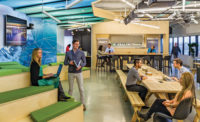New York, New York
TPG Architecture is developing a reputation at 7 World Trade Center. For prospective tenants of the David Childs–designed tower, the 29-year-old studio has become a go-to choice for interior fitouts. Currently the New York–based firm, which has long specialized in corporate interiors as well as retail design, is designing the 36th-floor office of branding and product company Arnell Group. And it got the job thanks in part to the headquarters it designed for Mansueto Ventures, located on a full floor just seven stories below.
Mansueto Ventures publishes Fast Company and Inc., both of which Joe Mansueto acquired in 2005 as part of his establishing Mansueto Ventures. The move to 7 World Trade Center not only signaled new ownership, but also allowed the magazine brands to practice the innovative business approaches that they preach. TPG’s design of the interior is contemporary and community-minded, while celebrating the best qualities of the building that contains it.
The project was overseen by Jim Phillips, AIA, founder of TPG, and associate principal and managing design director Luc Massaux. Massaux says he was initially floored by the vistas overlooking Ground Zero and weaving through the canyons of the Financial District to New York Harbor beyond. “The first time we visited the space, we were like, Wow, the big idea is the view. We want the view to be the scene, the outside to be inside.”
The resulting office design, Massaux continues, is meant to express the daylight-filled, weightless quality of alighting on the 29th floor for the first time. Structure and mechanical systems remain exposed. Perimeter offices are 10x10-foot glass enclosures by Unifor whose contents barely obscure the remarkable views. And wherever there are necessary dividers, large swaths of that partition appear to have been carved out to express thinness: Above the storage unit that forms one wall of the conference room adjacent to the entrance, for example, a wall of rippling glass diffuses light to the office space behind it and evokes the surface of the water within sight.
An equally big idea, Phillips says, is that the Mansueto Ventures office encapsulates “today’s way of working. The culture here is predominantly young and focused on collaboration and energy and sharing. It’s not about status, about the size of an office or how many years someone has accumulated.” Appropriately, each corner of the floor is devoted to conference or other communal space, rather than to the traditional executive suite.
Moreover, tapping into the contemporary work environment is not at odds with the architects’ first inspiration to “reveal the exterior,” as Massaux puts it. “Functionally, the layout is all about openness.” Petite cubicle workspaces, which are woven around the corner conference rooms and perimeter offices, ensure good sight lines across the plan; magazine interns sit at a raised bar so that they may grasp, visually, the choreography of editors and art directors; and the entrance opens to a lounge and cafeteria area where designers, salespeople, administrators, and other employees decompress and mingle in a more unprogrammed setting. A sense of community is further expressed, if cheekily, inside the building’s reinforced-concrete core: Here, TPG capitalized on the otherwise empty space by lining walls with rows of red lockers, high school–style.
The lockers also provide an extra bit of personal storage for a layout that sacrifices individual workspace to achieve a sense of fluidity. Indeed, the architects admit that Mansueto Venture’s 186-person head count, distributed among 40,000 square feet, make the office almost as closely packed as a trading floor. And yet, too, the density could also be compared to the urban scene taking place just outside 7 World Trade Center’s expansive windows. As Phillips puts it, “Cities are all about human interaction and culture, and this office is about building culture within the organization.” That would explain the grafitti tags punctuating the employee kitchen and looming over the red lockers.
Epitomizing the city in miniature, two giant screens, each comprising 40 Dell computer monitors, are installed in front of two corner conference rooms. The screens portray real-time changes made to the issue of Fast Company or Inc. that’s in production. Surely, then, this interior design is tailor-made to the publishing industry? Not so, say the architects. TPG is realizing this and similar visions for unexpectedly conservative clients, even for the new Washington, DC, headquarters of United Way. “Everybody’s moving in that direciton. I think people don’t want to come to work and feel that they’re stuck in a workstation,” Massaux says. Phillips concurs: “The Dilbertville partitions are coming down.”

